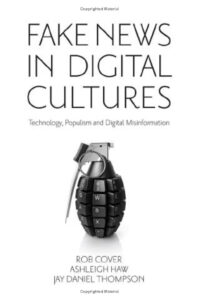
The authors take on the gargantuan task of trying to simplify and disentangle complicated and often misused concepts and terms. This includes defining words that have become overused and often misused in discussions such as ‘fake news’, ‘misinformation’, and ‘disinformation’; describing in detail how each differs from the other along with the potential (intentional or unintentional) threats each of them poses. They also devote a chapter to ‘truth’ and ‘post-truth’ in which they try to clear up the fairly complicated subject, explaining how the cultural phenomenon of ‘post-truth’ became prolific. In support of their main thesis, the authors argue that the mainstreaming of populism in different parts of the world, and the rise of online interactivity fostered the rise of the post-truth era, making it a natural emergence in today's culture.
While this work attempts, and succeeds in some parts, to achieve the admittedly complicated task of tackling one of the biggest hurdles in modern communication, it falls short at several points. First, despite promising a new angle, much of what is proposed has been discussed at length in different ways in other works, in the media and communication fields, as well as amongst people outside academia (see Corner 2017, Mihailidis and Viotty 2017, Schou 2019, Bernecker et al. 2021). Fake news has become so common, that as the authors say, one cannot assume that the general public would not know about it.
The most notable shortfall of the book is that the target audience remains elusive throughout. It is unclear if the authors are addressing their work to fellow academics, early undergraduate students, or the general public. Academics in the same or adjacent fields in the social sciences, would most certainly already be familiar with what is proposed in the manuscript, and while some parts may peak their interest, it is unlikely any of it will be considered novel. Although it seems that the goal of the book is to propose a new approach while simplifying complicated concepts and rendering them approachable, the writing in the book is still complex and laden with academic jargon that makes it, at times, quite inaccessible.
Components of this volume would likely prove useful for undergraduate students in digital culture courses where many of the concepts could provide a good start for class conversations and debates (particularly on the theories proposed in the book). Yet, it could still be argued that current undergraduate students (who are now mostly generation Z, predominantly those born after 2000) would already be extremely familiar with how the internet works and find the examples provided in the book outdated.
Additionally, despite the book implying a general focus on fake news and digital culture, it remains squarely in the anglo-saxon world, with very few exceptions throughout the book (including a brief mention of regulations against disinformation in Singapore). In advancing a cultural argument, delineating the geographical focus of the work would have been extremely beneficial. Claiming a new cultural theory without a clear indication of the regions to which it refers makes the work challenging to apply generally or specifically.
After discussing several interesting concepts related to fake news throughout the work (eg., the role of hyperreality, satire, sensationalism, and conspiracy theories), the authors move to the promised new resolution they were to propose. The authors argue that the methods used thus far fall short of actually enacting positive changes. They rightly believe that regulating speech through state laws and regulations has various shortcomings, and that it can easily become problematic as discerning between, for instance, what is comedy and what is fake news can prove to be a very difficult task. They further argue that the current approaches to digital literacy and pedagogical changes are still insufficient to tackle the issue at hand.
Cover, Haw, and Thompson thus argue that the main way to regulate, or rather mitigate, the threat of fake news is by looking at it through an ethical lens. Using Judith Butler’s (2004, 2009) approach to “precarity, subjectivity, and ethics” , the authors propose viewing the act of creating or disseminating fake news as an inherently violent one that pollutes communication ecologies. Believing and accepting that causing harm to others is ethically incorrect, they argue, is the best way to approach this global issue. Regulations and pedagogical approaches to mitigating or stopping fake news, will only be effective, they say, if they have an ethical foundation.
While the authors’ proposed solution is a laudable one that would certainly make for great class discussion. Many of the reasons behind the circulation of fake news are financial and political, this makes discussions on ethics much more complicated, and calls into question the viability of an ethics-driven strategy for combating fake news. As Philip Seib (2021) notes in his seminal work Information at War, fake news serves many more purposes and poses far more danger than those illustrated in the examples offered in this book. I, thus, find it a much too utopic solution for an issue that has become such a ubiquitous part of society. As much as we would all certainly enjoy a world where ethics dictate human behavior, the very concept of ethics and right and wrong, as we know, varies drastically from person to person, let alone culture to culture. Teeming with jargon, the last chapter of the book falls short of what was promised to the readers throughout.
In sum, the book proposes a new cultural approach to understanding and interpreting the complex issue of fake news, it argues against treating it as a sudden parasite and attempts to dissect and simplify topics related to misinformation, disinformation, fake news and new technologies. While chapters of this book could easily and successfully be assigned to undergraduate students, much of it remains, as previously stated, underwhelming or inaccessible for other audiences. Lastly, while the cultural and ethical theories articulated in the book certainly merit further discussion, the manuscript overall lacked substantial examples that would truly demonstrate the dimensions of the topic at hand and more palpable solutions than the ethical one proposed.
Fake News in Digital Cultures
Rob Cover, Ashleigh Haw, and Jay Daniel
(Emerald Publishing 2022)
 Arab Media & Society The Arab Media Hub
Arab Media & Society The Arab Media Hub





